








Designed by Nigel G Wilcox






The Paragon Of Metal Detecting
& Archaeology
& Archaeology
Powered By Sispro1
Anglo-Saxon & Viking A.D. - Currency Numismatics,
Silver Penny
For Reference ONLY
Everything For The Detectorist
Sliver Penny
**
Coenwulf 796-821 AD (Mercia)
Copyright All Rights Reserved by Nigel G Wilcox E-Mail: ngwilcox100@gmail.com
Viking Menu
Viking Timeline
Anglo-Saxon Timeline
1. COENWULF [796-821] silver penny
Portrait type - Group 11
CANTERBURY mint - Moneyer - DUDA
obv. +COENVVLF REX m
rev. +DVDA MONETA
1.32g
ref. Naismith C40g [this coin - pl.23], North 350, Spink 915
2. COENWULF [796-821] silver penny
Tribrach type
CANTERBURY mint - Moneyer - ETHELMOD
obv. +COENVVLF REX rev. +EDELMOD, around tribrach moline of 2 lines
1.25g
3. COENWULF [796-821] silver penny
Tribrach type
CANTERBURY mint - Moneyer - DUDA
obv. +COENVVLF R.EX rev. DV / D. / A
1.27g
4. COENWULF [796-821] silver penny
Tribrach type
CANTERBURY mint - Moneyer - LUDOMAN
obv. +COENVVLF REX rev. LVD / OM / AN
1.15g
ref. Naismith L13, North 342, Spink 914
Found - Norfolk 2013
Rare moneyer - only 3 recorded in Naismith and this is probably the best lighter than photo
and slightly porous surface in places VERY RARE
5. COENWULF [796-821] silver penny
EAST ANGLIA mint - Moneyer - WODEL
Portrait type
obv. COENVVLF REX, crude bust rev. PO d E L, in angles of cross
1.31g
ref. Naismith E13.3m [this coin],North 370, BMC 91, Spink 919-20
Found in Wilstead, Bedfordshire, Dec. 2005 Recorded - EMC 2006.0055
chipped lower edge and slightly wavy flan EXTREMELY RARE
6. Coenwulf. 796-821. AR Penny (1.32 g, 12h). Group IV, Pincer Cross type. Canterbury
mint; Diormod, moneyer. Struck circa 815-821. + COENVVLF REX m, diademed bust
right / + DIORmOD mONET? around pincer cross. Blunt, Coinage 44e (this coin,
illustrated); SCBI 20 (Mack), 583; BMC 68; North 347; SCBC 916. Good VF, attractively
toned. Good metal. Very rare.
Portrait type - Group 11
CANTERBURY mint - Moneyer - DUDA
obv. +COENVVLF REX m
rev. +DVDA MONETA
1.32g
ref. Naismith C40g [this coin - pl.23], North 350, Spink 915
2. COENWULF [796-821] silver penny
Tribrach type
CANTERBURY mint - Moneyer - ETHELMOD
obv. +COENVVLF REX rev. +EDELMOD, around tribrach moline of 2 lines
1.25g
3. COENWULF [796-821] silver penny
Tribrach type
CANTERBURY mint - Moneyer - DUDA
obv. +COENVVLF R.EX rev. DV / D. / A
1.27g
4. COENWULF [796-821] silver penny
Tribrach type
CANTERBURY mint - Moneyer - LUDOMAN
obv. +COENVVLF REX rev. LVD / OM / AN
1.15g
ref. Naismith L13, North 342, Spink 914
Found - Norfolk 2013
Rare moneyer - only 3 recorded in Naismith and this is probably the best lighter than photo
and slightly porous surface in places VERY RARE
5. COENWULF [796-821] silver penny
EAST ANGLIA mint - Moneyer - WODEL
Portrait type
obv. COENVVLF REX, crude bust rev. PO d E L, in angles of cross
1.31g
ref. Naismith E13.3m [this coin],North 370, BMC 91, Spink 919-20
Found in Wilstead, Bedfordshire, Dec. 2005 Recorded - EMC 2006.0055
chipped lower edge and slightly wavy flan EXTREMELY RARE
6. Coenwulf. 796-821. AR Penny (1.32 g, 12h). Group IV, Pincer Cross type. Canterbury
mint; Diormod, moneyer. Struck circa 815-821. + COENVVLF REX m, diademed bust
right / + DIORmOD mONET? around pincer cross. Blunt, Coinage 44e (this coin,
illustrated); SCBI 20 (Mack), 583; BMC 68; North 347; SCBC 916. Good VF, attractively
toned. Good metal. Very rare.
1.
| 1. Estimated value: 2,250 |
Coenwulf (also spelled Cenwulf, Kenulf, or Kenwulph) was King of Mercia from December 796 until his death in 821. He was a descendant of a brother of King Penda, who had ruled Mercia in the middle of the 7th century. He succeeded Ecgfrith, the son of Offa; Ecgfrith only reigned for five months, and Coenwulf ascended to the throne in the same year that Offa died. In the early years of Coenwulf's reign he had to deal with a revolt in Kent, which had been under Offa's control. Eadberht Præn returned from exile in Francia to claim the Kentish throne, and Coenwulf was forced to wait for papal support before he could intervene. When Pope Leo agreed to anathematize Eadberht, Coenwulf invaded and retook the kingdom; Eadberht was taken prisoner, was blinded, and had his hands cut off. Coenwulf also appears to have lost control of the kingdom of East Anglia during the early part of his reign, as an independent coinage appears under King Eadwald. Coenwulf's coinage reappears in 805, indicating that the kingdom was again under Mercian control. Several campaigns of Coenwulf's against the Welsh are recorded, but only one conflict with Northumbria, in 801, though it is likely that Coenwulf continued to support the opponents of the Northumbrian king Eardwulf.
Coenwulf came into conflict with Archbishop Wulfred of Canterbury over the issue of whether laypeople could control religious houses such as monasteries. The breakdown in the relationship between the two eventually reached the point where the archbishop was unable to exercise his duties for at least four years. A partial resolution was reached in 822 with Coenwulf's successor, King Ceolwulf, but it was not until about 826 that a final settlement was reached between Wulfred and Coenwulf's daughter, Cwoenthryth, who had been the main beneficiary of Coenwulf's grants of religious property.
He was succeeded by his brother, Ceolwulf; a post-Conquest legend claims that his son Cynehelm was murdered to gain the succession. Within two years Ceolwulf had been deposed, and the kingship passed permanently out of Coenwulf's family. Coenwulf was the last king of Mercia to exercise substantial dominance over other Anglo-Saxon kingdoms. Within a decade of his death, the rise of Wessex had begun under King Egbert, and Mercia never recovered its former position of power
Coenwulf came into conflict with Archbishop Wulfred of Canterbury over the issue of whether laypeople could control religious houses such as monasteries. The breakdown in the relationship between the two eventually reached the point where the archbishop was unable to exercise his duties for at least four years. A partial resolution was reached in 822 with Coenwulf's successor, King Ceolwulf, but it was not until about 826 that a final settlement was reached between Wulfred and Coenwulf's daughter, Cwoenthryth, who had been the main beneficiary of Coenwulf's grants of religious property.
He was succeeded by his brother, Ceolwulf; a post-Conquest legend claims that his son Cynehelm was murdered to gain the succession. Within two years Ceolwulf had been deposed, and the kingship passed permanently out of Coenwulf's family. Coenwulf was the last king of Mercia to exercise substantial dominance over other Anglo-Saxon kingdoms. Within a decade of his death, the rise of Wessex had begun under King Egbert, and Mercia never recovered its former position of power
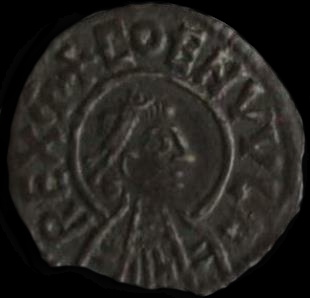

| 2. Estimated value: 875 |
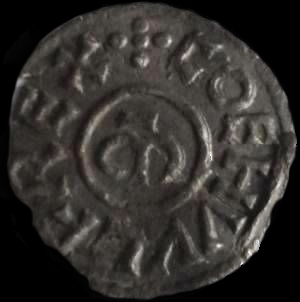
2.
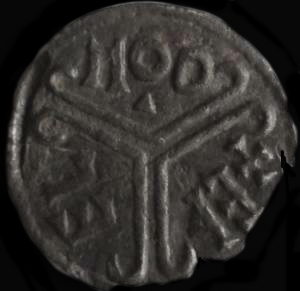
3.
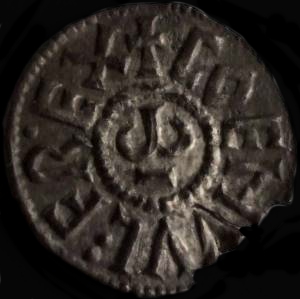
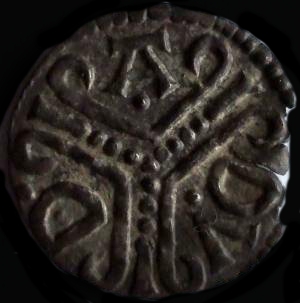
| 3.. Estimated value: 950 |
| 4.. Estimated value: 1500 |
4.
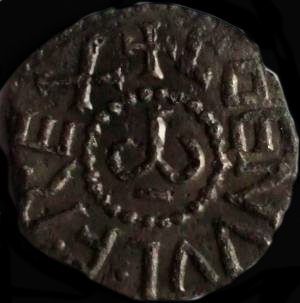
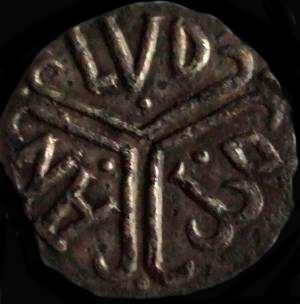
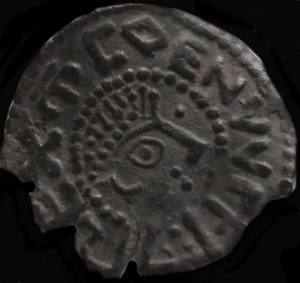
5.

| 5.. Estimated value: 650 |
| 6. Estimated value: 5000 |

Pages
Information Data
Main Coin Menu
Anglo-Saxon
Menu
Menu
Member NCMD
A.S. Menu
























